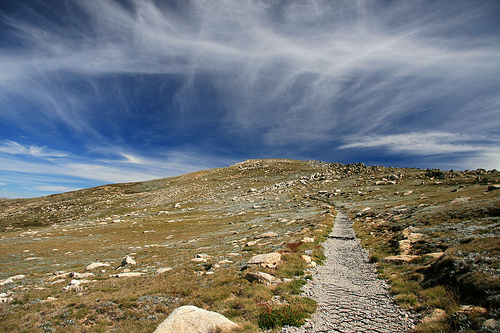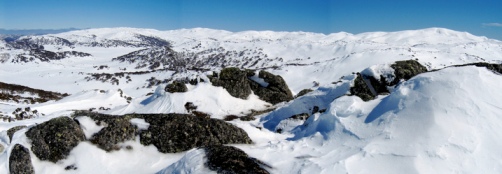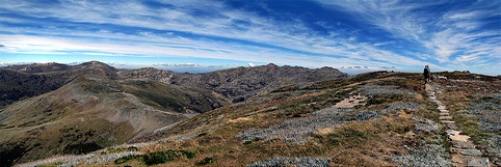Mount Kosciuszko EarthCache EarthCache
Mount Kosciuszko EarthCache
-
Difficulty:
-

-
Terrain:
-

Size:  (other)
(other)
Please note Use of geocaching.com services is subject to the terms and conditions
in our disclaimer.
Note: Some GPS users: The information on this page is fairly lengthy and may not be completely displayed on your GPS. You should print this page before attempting the EarthCache.
Please read the disclaimer at the bottom of the page before setting off on your adventure.

If you really enjoyed finding this Earthcache, please mark me as a favorite
This EarthCache is situated on top of Mount Kosciuszko which is located in Kosciuszko National Park. Mount Kosciuszko is the highest mountain on the Australian continent standing at 2,228M forming part of the Snowy Mountains and Great Dividing Range. Kosciuszko National Park covers 690,000 hectares, contains the famous Snowy River, all NSW ski fields, spectacular caves and limestone gorges; hydro electric power stations, scenic drives; and historic huts and homesteads.
Permission was granted from the Department of Environment, Climate Change and Water to place this EarthCache in the National Park. Please remember the Geocaching motto of "Leave No Trace".
You must enter the Kosciuszko National park to find this EarthCache.
The cost to enter the Kosciuszko National Park is as follows:
- $27 from the start of the June long weekend to the end of the October long weekend
- $16 throughout the rest of the year
- $190 for an annual pass(including Kosciuszko)
Before attempting this EarthCache:
I strongly recommended checking the current weather conditions and forecast. The weather in the Snow Mountains can change dramatically and you MUST be prepared. Even if it’s sunny in the village, a blizzard can be raging up top. It can drop below freezing and snow any time of the year. Hyperthermia and frost bite can occur if you’re not prepared, so please extra take care.
Below is a list of items that you should consider taking on your journey:

- Extra Clothes
- Sun Screen
- Sun Glasses
- GPS
- Camera
- A printed copy of this page!
- Extra GPS batteries
- Drinking water & snack/lunch
- Wear sturdy walking shoes
- Pen and paper for your notes
- Mobile phone
Ascending the summit and reaching the EarthCache
This is the easiest of 7 highest peaks on 7 continents to reach. Over 100,000 people visit the summit each year. There are a few different ways to reach the summit (The EarthCache).
Walking/Biking to the summit can be done year round but you can expect deep heavy snow from June through October. Sometimes the snow can be so packed you can walk across it using shoes with spikes. The ideal time to make the accent is from November to Macrh
By Foot/Bike:
1) By foot or Bike: Follow Kosciuszko/Summit Rd to Charlotte Pass. This road is usually closed from Perisher Valley during the winter months. From here it's an 8Km walk up a path to the summit. Anyone with a modest level of fitness should be able to walk it. The walking track to Mount Kosciuszko from Charlotte Pass is in fact an old road, which was closed to motor vehicle access due to environmental concerns. This track can also be used to ride a bike as far as Rawson's Pass, where you must leave it and continue onto the summit by foot.
2) (Preferred Method) By foot/chairlift: Make your way to Thredbo Village. From here take the Crackenback chairlift to the top of Thredbo Ski resort. From here it’s a 6.5Km walk and it should take about 1 hour 45 minutes to reach the summit. This is not a difficult walk along a raised mesh walkway. The chairlift is open from 9am to 4.30pm daily for the cost of $19 one way or $24 round trip. If you miss the 4:30 p.m. deadline you will have to hike down 560 vertical meters to the bottom of the lift. No bikes are permitted beyond the chairlift towards Mt Kosciuszko.
Both tracks meet at Rawson's Pass for the final assent to the Kosciuszko summit. Australia's highest public toilet was built here in 2007 at an altitude of 2,100M. No bikes are permitted beyond this point.

3) Cross Country Ski/Snow Shoe: By starting at the top of Thredbo or Charlottes Pass you can follow close to the walking route (It’s marked by snow poles as a guide) and cross country ski or snow shoe to the summit. As the snow can be very hard packed, snow shoes are not recommended.
About the EarthCache:
During the last ice age, which peaked about 20,000 years ago in the Pleistocene epoch, the highest peaks of the main range near Mount Kosciuszko experienced a climate which favoured the formation of glaciers, evidence of which can still can be seen today. Cirques moraines, tarn lakes, roche moutonnées and other glacial features can all be seen in the area. Lake Cootapatamba, which was formed by an ice spilling from Mt Kosciuszko's southern flank, is the highest lake on the Australian mainland. Lake Albina, Club Lake, Blue Lake, and Hedley Tarn also have glacial origins.
There is some disagreement as to exactly how widespread Pleistocene glaciation was on the main range, and little or no evidence from earlier glacial periods exists. The 'David Moraine', a one kilometer long ridge running across Spencers Creek valley seems to indicate a larger glacier existed in this area at some time, however the glacial origin of this feature is disputed.
There is evidence of periglacial activity in the area. Solifluction appears to have created terraces on the north west flank of Mount Northcote. Frost heave is also a significant agent of soil erosion in the Kosciuszko Area.


To claim this EarthCache you must do the following:
Message me the required answers. Do not post these in your log except the answer to question 5.
1) In a message describe the colour and texture of the largest rocks close to the summit of Mt Kosciusko. Do not get confused with any rock that may have been placed on or near the pathway. Although these large rocks “should” be visible during the winter months you may need to expand your search if the summit is covered in snow. At worst, you may have to pull out your snow shovel and start digging.
2) From the summit, look to the North East and note the terrain. Then from the summit look South West and note the terrain. In an email describe the different in terrain between the 2 directions.
3) Take a photo of yourself and GPS on top of Mt Kosciusko clearly showing your GPS next to the Trig Station at the highest point.
4) At the Trig Station locate the words that are etched in the metal. Email me these words.
5) With your GPS measure the height of Mt Kosciusko and post it in your log. In the past there was some discrepancy whether Mt Kosciusko or Mount Townsend was the highest Mountain in Australia.
Internet finds are not permitted. You must visit the EarthCache, answer all of questions and post a photo to claim this find.
There is no need to wait for a confirmation to log this earthcache. I read all messages to verify the correct information was sent and will contact you if there are any problems with your answers. Likewise, there is no need to email me photos. Just upload any photos with your log. If both tasks are not completed within a timely manner of logging your cache online your log will be deleted.
** Congratulations to Bloodnut for the FTF on the 20th of October 2009. **
Thanks to the Department of Environment, Climate Change and Water for allowing this EarthCache to be placed in the National Park.

Disclaimer: Always exercise common sense and caution while geocaching. Any person attempting this cache and/or any related activities assumes all liabilities and personal responsibility for any and all damages or injuries of any kind. If you do not agree to these terms and conditions, do not attempt for this cache.
Additional Hints
(No hints available.)